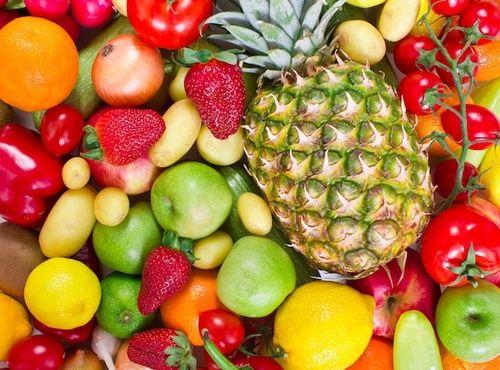La fruit it is a food with high nutrient density and low calorie density, rich in important nutrients. With important functions mineralizzanti e vitaminizzanti, it also has laxative properties and stimulates digestion. Let's find out better.
> 1. What is fruit
> 2. How the fruit is made up and classified
> 3. Properties and benefits of fruit
> 4. Ally of
> 5. How to choose fruit

What is fruit
The fruit forms a more homogeneous food group than that of vegetables and greens. There are, however, differences in its nutritional value and in its conservation possibilities; these relate to conformation (peeled fruit is often less fragile than thin-skinned fruit), color (colored fruit is much richer in vitamins A and C) and diversity of genetic selection.
It is at full maturity that fruit reaches the maximum of its nutritional and gustatory qualities but ripe fruit does not always transport well and good fruit is not always beautiful: the selected varieties have been chosen more for their good suitability for transport and good looking than for taste or vitamin value.
There are very often discrepancies between the botanical concept of fruit - intended as a product of transformation of the ovary of the flower after fertilization - which also includes some vegetables such as aubergines, tomatoes, pumpkins, etc. and the meaning that is correctly attributed to it, that is that of food that usually serves to conclude a meal . For the botanist, therefore, there is no difference between fruit and vegetables: an eggplant is a real fruit as much as a peach, even if it is not sweet!
Still from a botanical point of view, the function of the fruit is to protect and accompany the development of the seeds and embryos they contain, also favoring dissemination, which is useful for the plant for the spread of the species and to reduce competition phenomena. 'interior of the same species that we would have if the new seedlings were born at the foot of the mother plant.
How the fruit is made up and how it is classified
In general, in the fruit we distinguish three layers: exocarp, mesocarp and endocarp which together form the pericarpo that surrounds the seed or seeds. Sometimes these three layers are very evident, for example in peaches they correspond to peel, pulp and stone containing the seed. Many other times, however, these layers are much less distinguishable, for example in grapes.
A first classification of the fruits is between true fruits and false fruits or apples. In the first case the fruit derives only from the ovary of the flower, in the second also from the receptacle that surrounds the ovary (for example in an apple or in a pear: the part we eat comes from the receptacle, the part instead that contains the seeds and that we discard derives from the ovary).
A second distinction is between fleshy fruits and dried fruits. For the distinction it is necessary to observe the fruit at maturity, that is when the seeds are fully developed and ready for dissemination. If at this point the fruit is still more or less pulpy and hydrated, it is a fleshy fruit (apples, watermelons, lemons), if instead all the cells of the fruit are dehydrated and therefore dead and alive there are only the seeds contained in it. , then it is a dry fruit (hazelnut, legume, caryopsis).
For botany these "dried fruits" are a completely different thing from "dried fruit": for example the almond tree and the peach tree produce the same type of fleshy fruit, the drupe, only that we eat from the almond what we throw away from a peach, that is the seed contained in the core.
Given the extreme variety of nutritional principles in the different fruits, there is also the need to divide the fruit into:
- acidulous-sugary: apples, pears, peaches, plums, grapes, apricots, cherries, strawberries, raspberries;
- acidify: contains about 15% of sugars providing a maximum caloric intake of about 60Kcal (citrus);
- sugary: contains more than 15% of sugars providing a caloric intake exceeding 70 Kcal (figs, bananas, pineapples);
- floury: chestnuts;
- oily: contains a high quantity of lipids (50-65%) and proteins (10-20%) as well as a fair quantity of carbohydrates (15-20%). The caloric intake is about 600 Kcal (peanuts, walnuts, hazelnuts, almonds, pine nuts, pistachios).
The fruit-based diet: all the pros and cons of fruitarianism

Properties of fruit
Fruit, with the exception of the oily one, is a food with a high nutritional density and a low calorie density characterized by a whole series of nutritional principles:
- high water content (from 80 to 96% of weight; the maximum is found in the watermelon)
- high content of vitamins A and C
- mineral salts such as K, Mg, Fe, Ca which are guaranteed by fruit and vegetables, in industrialized countries, for about 1/5 of the recommended quantities
- dietary fiber (cellulose, hemicellulose and pectin)
- irrelevant protein and lipid content
- good sugar content (sucrose and fructose) present mainly in pulpy and sugary fruit.
We must remember that in fruit they are also present potentially toxic substances (cyanogenetic glycosides, nitrates, oxalates, antithyroid drugs, solanine).
Fruit, ally of
The protective role of the nutrients contained in fruit and vegetables is now well known. These numerous chemically isolated, purified and administered principles, however, do not have the same positive effects as when they are in the fruit because their action is a synergy that occurs with all the other plant components (essential oils, tannins, pectins, etc.) present in the fruit. same.
The main functions of fruit and vegetables are:
- vitaminizing action thanks to the significant supply of vitamins;
- mineralizing action exercised above all by salts of calcium, iron, copper, cobalt, manganese and zinc;
- diuretic and detoxifying action thanks to the prevalence of potassium which facilitates the elimination of the products of nitrogen metabolism and the excess of chlorides;
- alkalizing action useful against protein foods (acid-formers);
- laxative action exerted by the fiber that stimulates intestinal peristalsis (even if some fruits contain high quantities of tannins with astringent properties, e.g. in quinces, medlar, raspberries);
- stimulating digestion determined by organic acids (citric, ascorbic, etc.) which stimulate the production of digestive juices.
How to choose it
In order to optimally use the nutrient content, the fruit should beand consumed after harvest - many vitamins are reduced over time -, raw - vitamins A, B, C and E are deactivated by heat - and not excessively washed - vitamins B and C are water-soluble as well as mineral salts.
For the first point, it can be remedied with the consumption of local products on a seasonal basis which guarantees:
- ripening on the plant
- the best flavor
- the increased supply of nutrients
- the guarantee of freshness
- the reduced presence of preservatives
- known cultivation practices (EU)
- savings
- a naturally varied diet.
In general it can be said that the more the productions are distant from the region of consumption, the less the guarantees of quality and freshness.
To overcome the problem of not washing fruit excessively, it should be emphasized first of all that washing is essential to remove all those chemical pollutants used in modern agriculture and that therefore preferring fruit from organic or biodynamic agriculture, can be a good compromise.
READ MORE
All the properties and benefits of vegetables


























